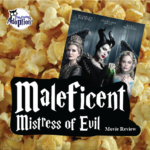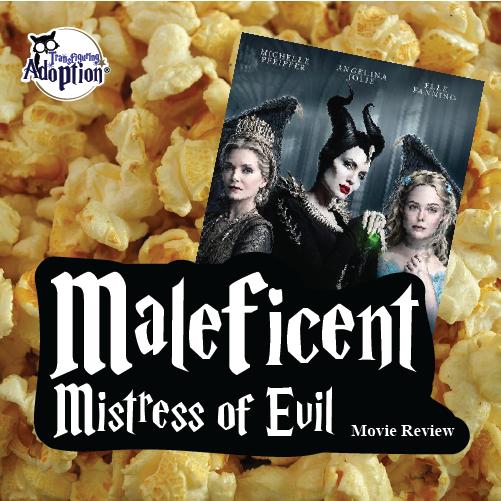Transfiguring Adoption’s Thoughts:
Before watching this film, it is a good idea to have seen the first “Maleficent” film released in 2014. Simply having knowledge of Maleficent through the Disney classic “Sleeping Beauty” is not enough for you to understand the background of Maleficent, which is information needed to truly understand this current film. Maleficent happens to be my favorite Disney villain and I was THRILLED to go see this film.
The imagery was flawless and several scenes took my breath away by how beautiful the Moors were portrayed. I was captivated from beginning to end of this movie between the story line, the complex character development, and emotional connections between the characters. I would be lying if I said I did not cry my eyes out several times watching this film. I experienced a wide range of emotions including amazement, sadness, grief, shock, and joy. Despite being a Disney film, this movie should be enjoyed by families with older children (+12) who have already processed a lot of the trauma they have experienced in order to decrease the likelihood of being triggered.
If you have not watched the first “Maleficent”, the next few sentences might spoil it for you. The last “Maleficent” movie ended on a positive note, like many Disney movies do. This film references many incidents that occurred in the previous film. Maleficent has fully embraced motherhood and she exemplified every characteristic you would expect a Disney mother to possess: concern, over-protectiveness, and humor. Watching the interactions throughout the film between Aurora and Maleficent reminded me that family is not just about blood, sometimes it is the people who are willing to sacrifice themselves for you who are truly your family.
**Spoilers Could Be Ahead**
How is this related to adoption & foster care?
Although Maleficent is the God-Mother to Aurora, she is more maternal towards her than anything. Aurora considers Maleficent to be her mother and refers to her as such on many occasions. Maleficent was the one protecting her while she was growing up due to her own mother not being around. Aurora is raised by three fairies along with Maleficent, which is similar to many of our children who were in foster care/adoption.
This film centers around several tragedies. Some of the fairies are going missing. They are being taken from their homes and families in the middle of the night. This is an event that far too many of our children have been exposed to. Aurora and Prince Philip get engaged and the King & Queen insist that Aurora and Maleficent attend dinner at the castle. The dinner went about as poorly as one would expect. Aurora ends up feeling torn between her future in-laws and her mother, Maleficent. This is not uncommon between children in foster care with their foster families and biological family. Different environments require different rules and it can be hard to find a balance in being respectful of another family’s home and staying true to yourself.
Aurora continues to stay at the castle and Maleficent is in a foreign land trying to recover from her wounds. Maleficent feels accepted and enjoyed being surrounded by people who look like her for the first time. She learns about the culture of her people and appears to be happy. This was such a great moment of representation of children who have been adopted without any knowledge of their life story. Understanding one’s genetic makeup and culture is so empowering, and it takes away the sense of wonder when a child is unaware of their history. Every child should feel connected to their ancestry in some way and the way it was portrayed in the film was beautifully done.
Discussion Points:
- Maleficent going outside of her comfort zone to try and make a good impression
It’s amazing what parents will do in order to make their child happy. Despite Maleficent not wanting to eat dinner at the castle and feeling uncomfortable, she tries her best to be friendly and engage with the king and queen because of her love of Aurora. Aurora is able to recognize this and appears to appreciate the effort, despite how poorly the situation ended up being handled. Sometimes as parents we ask our kids to go outside their comfort zone for various events, but it is great to remember that sometimes our kids need us to do so as well for them. - Understanding ones culture helps one understand themselves
Culture competency in adoption is a hot topic for me. I love seeing blended families but it is important to be sensitive to the culture of your child, even if they are unaware of any of the actual practices. Allowing your child to feel connected to their roots and experiencing new traditions with them can deepen the bond that you have. Although they may not have any culture preferences besides the one that your family holds due to being adopted at a young age, it is never a bad idea to try and find out what practices their biological family had. Did they celebrate Dia de Muertos (Day of the Dead), have relatives that survived or perished in the Holocaust, or participate in the celebration of Kwanzaa? If so, try to incorporate some of these traditions into your own. Other suggestions include learning how to cook authentic cuisine to enjoy as a family and even traveling to their culture’s mainland for a more immersive experience. - Past hurts can leave scars
No matter how much safety and love our children receive from us once they are part of our family, there will always be some residual trauma left over. While our mind may forget what happened, our body will remember. It’s important to remember that when our children’s reaction does not match the situation, it is most likely trauma based. Throughout the movie there are many instances where past situations influence the decisions being made. Multiple traumas have caused anger and resentment to occur between both neighboring lands. Harboring that ill will requires a lot of resources, energy, and strength. Over time both parties recognize that it is better to put the past to rest and move forward in a positive manner, but our kids likely don’t have the ability to have that conversation with the people who hurt them in the past which makes it more problematic to process their emotions. - “Curses don’t end, they are broken”
Generational patterns are one of the main components that I see on a regular basis when it comes to child abuse. Often times, the biological parents of our children parent their children based on their childhood. One thing I like to remind parents of is “you can’t give what you were never given”. This is a broad statement and may not apply to some parents, but for the majority they are simply fulfilling their part in their generational curse. Your child now has the opportunity to break that curse with your help. In the movie, true love is what breaks the curse that is placed on the King. Maleficent was blamed for cursing the King, however it is later discovered that someone else was the mastermind behind the curse. As adoptive and foster parents, we sometimes only get a small snapshot of what actually happened. Between child studies, assessments, and statements made by child welfare professionals, we create this synopsis in our head of everything the biological parents did wrong. Rarely does anyone focus on what the biological parents did right. There are two sides to every story: what was reported and the truth. We need to find a balance between helping our child end their generational trauma without enforcing the idea that their biological family was “bad”, as our children are products of that environment.
Cautionary Points:
- Multiple triggers in the film
Kidnapping, murder, and war are consistently shown throughout this film. Although the movie is not gory in details of death, they do not shy away from showing fairies and humans dying. This can be traumatic for people who have experienced death through violence. - Loud noises
Due to this film being heavy in war and fighting, there are loud explosions and yelling throughout the movie. Children who struggle with sensory processing should maybe skip out in seeing this film in theaters where the audio is generally already louder than usual. If your theater offers a sensory movie time to accommodate for this, that may be a good alternative if you want to see the movie before it is released when you can control the volume in your home. - Cruelty to people who are different
In the movie, fairies are considered freaks and are treated as such. Throughout the film, there are many instances of torturing them due to being different. Our children may empathize with them due to feeling like they are different as well. We need to be really sensitive to this connection and be willing to help them process whatever emotions are present due to this film. - Loss of parent
The climax of the film leads to Maleficent dying in front of Aurora. Aurora instantly appears in agony and despair. This can be especially difficult for our children who have grieved a loss of a parent, which honestly is all of them. Even if the biological parents are still alive, the process of adoption itself lends to feelings of grief, as they have lost the parent that they have known. It is easy to empathize with Aurora if you have ever experienced grief and it can bring up feelings that we have not felt in a long time.
[Donate to this Project]
ABOUT THE REVIEWER, PATTIE MOORE:
Pattie lives in Tampa, FL, and she spends most of her time working with adoptive and foster families through case management, psychiatry services, and therapy services. Pattie received her bachelor’s in psychology from Saint Leo University and her master’s in Marriage and Family Therapy from Argosy University. Pattie has been certified as an adoption competent provider through Rutgers University. Pattie has also participated in the Infant Mental Health certification program through University of South Florida, and is currently working on her CPP (child parent psychotherapy) certification. Pattie is also a current Guardian Ad Litem for Hillsborough County that specializes in working with teen girls in human trafficking. When Pattie isn’t working, you can find her at Universal and Disney with her husband and friends.
**Transfiguring Adoption is a nonprofit organization seeking to nurture growth in foster and adoptive families by giving a HOOT about their families. Transfiguring Adoption does not intend for its reviewers nor its review to be professional, medical or legal advice. These reviews and discussion guides are intended to help parents to better be able to connect and understand their children who come from traumatic backgrounds.

